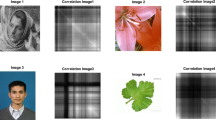Abstract
Texture classification of images is an important problem in texture analysis, with the goal to assign an unknown sample image to one of a set of known texture classes. Many procedures have been proposed. However, traditional texture classification methods are often complicated and time-consuming. In addition, the whole original data set has to be known in advance. This paper presents a novel approach to texture classification that employs cross-covariance matrices in the compressive measurement domain. Since there is a linear relation between the cross-covariance matrix in the measurement domain and that in the transform domain, the characteristics of the original signals can be reflected through the sampling measurements. By abstracting the measurement-domain cross-covariance matrices of each image class, we build a texton dictionary composed of the cross-covariance vectors and then train each image class according to the texton dictionary. Through comparison with all the training results, test images are classified as the matching one. Experiments show that the texture classification method proposed in this paper has better accuracy, with only 14–50 % processing time than the existing methods.





Similar content being viewed by others
References
Epifanio, I., Ayala, G.: A random set view of texture classification. IEEE Trans. Image Process. 11(8), 859–867 (2002)
Mokhtari, M., Razzaghi, P., Samavi, S.: Texture classification using dominant gradient descriptor. In: 8th Iranian Conference on Machine Vision and Image Processing, pp. 100–104 (2013)
Varma M, M., Zisserman, A.: A statistical approach to texture classification from single images. Int. J. Comput. Vis. 62(1–2), 61–81 (2005)
Guo, Z., Zhang, L., Zhang, D.: A completed modeling of local binary pattern operator for texture classification. IEEE Trans. Image Process. 19(6), 1657–1663 (2010)
Varma, M., Zisserman, A.: A statistical approach to material classification using image patches. IEEE Trans. Pattern Anal. 31(11), 2032–2047 (2009)
Zheng, J., Jacobs, E.L.: Video compressive sensing using spatial domain sparsity. Opt. Eng. 48(8), 087006-1-10 (2009)
Candès, E., Romberg, J.: Sparsity and incoherence in compressive sampling. Inverse Probl. 23(3), 969–985 (2007)
Rateb, A.M., Syed-Yusof, S.K.: Performance analysis of compressed sensing given insufficient random measurements. ETRI J. 35(2), 200–206 (2013)
Candès, E.J., Tao, T.: Decoding by linear programming. IEEE Trans. Inf. Theory 51(12), 4203–4215 (2005)
Liu, Li, Fieguth, P.W.: Texture classification from random features. IEEE Trans. Pattern Anal. Mach. Intell. 34(3), 574–586 (2012)
Donoho, D.L.: Compressed sensing. IEEE Trans. Inf. Theory 52(4), 1289–1306 (2006)
Jiang, F., He, K.: Color image enhancement based on sparse representation. In: International Conference on Control, Automation and Systems Engineering, pp. 1–4 (2011)
Lam, E.Y., Goodman, J.W.: A mathematical analysis of the DCT coefficient distributions for images. IEEE Trans. Image Process. 9(10), 1661–1666 (2000)
Guo, J., Song, B., Tian, F.: Perception of image characteristics with compressive measurements. IEICE Trans. Inf. Syst. E97–D(12), 3234–3235 (2014)
Candès, E.J., Plan, Y.: A probabilistic and RIPless theory of compressed sensing. IEEE Trans. Inf. Theory 57(11), 7235–7254 (2011)
Yang, S., Jin, H., Yang, L., Wenhui, X., Jiao, L.: Compressive sensing-inspired dual-sparse SLFNN for hyperspectral imagery classification. IEEE Geosci. Remote Sens. Lett. 11(1), 220–224 (2014)
Tuna, H., Onaran, I., Cetin, A.E.: Image description using a multiplier-less operator. IEEE Signal Process. Lett. 16(7), 751–753 (2009)
Tuzel, O., Porikli, F., Meer, P.: Region covariance: a fast descriptor for detection and classification. In: Computer Vision-ECCV 2006, pp. 589–600. Springer, Berlin (2006)
Acknowledgments
This work has been supported by the National Natural Science Foundation of China (61271173, 61372068), the Research Fund for the Doctoral Program of Higher Education of China (20130203110005), the Fundamental Research Funds for the Central Universities (K5051301033), the 111 Project (B08038), and also supported by ISN State Key Laboratory.
Author information
Authors and Affiliations
Corresponding author
Rights and permissions
About this article
Cite this article
Guo, J., Song, B., Tian, F. et al. Texture classification with cross-covariance matrices in compressive measurement domain. SIViP 10, 1377–1384 (2016). https://doi.org/10.1007/s11760-016-0902-9
Received:
Revised:
Accepted:
Published:
Issue Date:
DOI: https://doi.org/10.1007/s11760-016-0902-9




